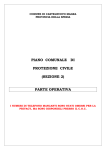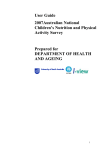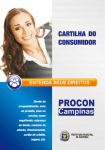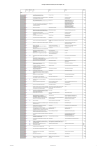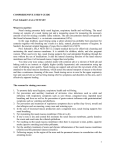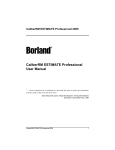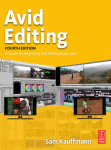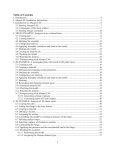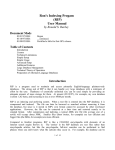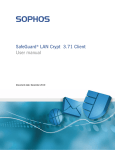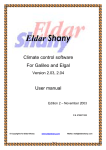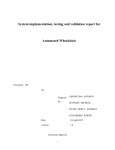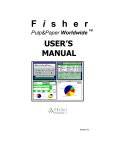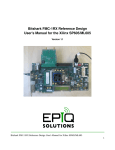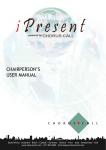Download The ENACT Course - Student`s version
Transcript
ENACT course in nutrition education Introductions and project folder Student’s version Introductions User manual Introductory slides Student's introduction Student briefing for Unit 1 Project folder ©Cristina Álvarez ENACT course in nutrition education Technical guide for users ENACT course in nutrition education Technical guide for users Contents Technical guide for users ENACT COURSE FILES 3 SOURCES 4 INSTALLING THE COURSE 4 1. Uncompressing (unzipping) files 4 2. Downloading and copying files 5 USING THE COURSE FILES 7 3. Editable documents 7 4. Form field types 8 5. Question types 9 6. Open the course 11 7. Adobe Reader tools 12 SUBMITTING YOUR WORK 14 ENACT course in nutrition education Technical guide for users Welcome to the ENACT course! This manual gives a guide to accessing and using the ENACT course files. ENACT course files The face to face version of the ENACT course is available in pdf format. The student version of the course contains the following files: Introductory files Course resources (5 files) Introductions (4 files including this User Manual) Project folder (7 pdf files, 1 Powerpoint file and 1 Word document) Unit files 5 files for each of the 11 units, comprising Introduction (slides introducing the units) The Student’s Book (the main workbook, containing learning materials and activities) The Unit Resources (documents for study) Two versions of the Printable workbook (a shortened version of the Student’s Book, available both in MS Word and in pdf format.) Some units contain additional materials, and Units 7 and 9 have an Extra Section of the Student’s Book. To ensure that all links work properly it is important to save the files on your computer with the same structure that they have on the CD Rom, as described later in this document. You should not try to convert the documents into another format. ENACT course in nutrition education Technical guide for users Sources The course is available to download from: the fao.org web site, the CD-ROMs (if provided), the link provided by the teacher of your ENACT course. Installing the course 1. Uncompressing (unzipping) files The course content is delivered in pdf format. It may be contained within zip files. Operating systems such as Mac OS, Windows or popular Linux distributions already have the required system program to extract files from a zip archive. Normally you can just click on the link to unzip and install the files. For help with uncompressing files, use these links. 1.1 For Windows systems Windows Vista http://windows.microsoft.com/en-us/windows/compress-uncompress-files-zipfiles#1TC=windows-vista Windows 7 http://windows.microsoft.com/en-us/windows/compress-uncompress-files-zipfiles#1TC=windows-7 1.2 For MacOs systems Mac OS X 10.9 Mavericks.Mac OS X 10.10 Yosemite https://support.apple.com/kb/PH19074?locale=en_US 4 ENACT course in nutrition education Technical guide for users 1.3 For Linux systems Ubuntu https://help.ubuntu.com/community/FileCompression On your computer create a folder that you can easily access and name it “ENACTcourse”. Copy the zip files and extract them one per one into the ENACT course directory. Once unzipped you can safely remove al the zip files. The files will be extracted into folders as in the image. Do not alter this structure as this will mean that links between files will be broken. 2. Downloading and copying files If you are downloading or copying files make sure you maintain the folder structure of the originals, as in the image here. IMPORTANT! If you are downloading from a website, you must save the file and open it from your Computer Resources, NOT from your web browser. When you click on the file and download it from the internet, a tab will appear on the bottom of your screen. If you open and work on the the file from here, you will not be able to save your answers. See the images on the next page. 5 ENACT course in nutrition education Technical guide for users Don’t open from here! Open from here! 6 ENACT course in nutrition education Technical guide for users Using the course files 3. Editable documents To read the files and write your answers to the questions you will need the Adobe Reader. This is free software which is already installed on many computers. To see which version you have, just open any pdf file, then go to Help>About Reader X. It is a good idea to get the latest version of the Reader, which is available here: https://get.adobe.com Most of the pdf files are protected: you cannot write on them or alter them. However, the Student’s Book and Printable Workbook files contain answer boxes which are not protected. Here you can write your answers directly on the computer. These boxes are called “fields” or “form fields”. They normally have a white background, as in this image: You can highlight the fields so that you can see them more easily. When highlighted they look like this: 7 ENACT course in nutrition education Technical guide for users You can save your answers directly in the pdf without using other files (see Save your work). Remember to save your work regularly and before you close the document. 4. Form field types Some of your answers will be assessed by your tutors, while for others you are expected to check your answer yourself in the Student’s Key. Assessed questions can be recognised by their orange borders. Your answers to these questions will appear in dark red text over a white background. 8 ENACT course in nutrition education Technical guide for users Non-assessed forms have no borders (as in the images on the previous pages), and your answers appear in dark red text over a white background They are not formally assessed, but your tutor will sometimes check them. 5. Question types There are four ways you can answer questions: by writing the answer, by pressing a button, by checking a box or by choosing from a list. These correspond to the four types of field used in the course (input text, radio button, checkboxes and choice list), as illustrated below. 9 ENACT course in nutrition education Technical guide for users Table 1: Ways you can answer questions Writing Pressing a button Checking a box Choosing from a list Writing You can type your answers in the space provided, or if you are using another document, you can copy and paste your notes. Radio buttons You can choose an answer from several options. 1.4 Figure 1 : Single choice options list. No choices have been made in this example When you choose you will see a dot inside the button. You can only choose one. Check boxes In a checkbox you can choose one or more answers, as instructed. When you make your choice it will look like this: 10 ENACT course in nutrition education Technical guide for users . Figure 2 : Multiple choice options list. No choices have been made in this example 1.5 Choice List In some choice lists you can only choose one answer. In others you can select more than one answer. In this case use the Ctrl key to select multiple choices in your answer. Figure 3 : A choice list 6. Open the course When opening a pdf file with Adobe Reader, the software will ask if you want to highlight the “form fields”. We suggest that you do this if you want to make them clearer. Click on the button as in the following image. 11 ENACT course in nutrition education Technical guide for users When you choose to highlight form fields the background colour will switch from white to pale blue. When you edit a field the colour will switch back to white or yellow. 7. Adobe Reader tools 1.6 Highlight text You can highlight text by using the highlight tool, as below: 12 ENACT course in nutrition education Technical guide for users Figure 4 : Highlighted text 1.7 Comments You can add your own comments using the comment tool (see below). This may help you keep track of your ideas. Figure 5: Insert comments 1.8 Zoom If you want to make the text bigger or smaller you can use the Zoom tool. 1.9 Page Fit You can manage how the page fits your screen using the page fit tools or the page display commands under the View menu. 13 ENACT course in nutrition education Technical guide for users 1.10 Print You can print a document using the printer icon or Ctrl+P or Cmd+P 1.11 Search The search (Ctrl+F or Cmd+F) or the advanced search (Ctrl+Shift +F or Cmd +Shift +F) tools allow you to search for a keyword in the document. Figure 6: Simple search Submitting your work There are several ways of submitting your work, and your tutors will tell you which one they prefer. a. On the computer You can write your answers on the computer, in the Student’s Books or the Printable Workbooks (pdf or Word version), and save the file. If you use the full Student’s Book your files will be very large, and if you print the documents there will be a great deal of expensive printing to do. For these reasons we suggest you use the Printable Workbooks. However, the 14 ENACT course in nutrition education Technical guide for users Printable Workbooks need to be used together with the complete Student’s Book. You can refer to the Student’s Book either on your computer or via a printed copy, if the university is able to provide one. When you have completed the workbook, deliver it to your tutor in one of these ways:. i) On a USB stick or similar support ii) By e-mail iii) By printing it and delivering a hard (paper) copy iv) Via the Adobe software system for collecting data from form fields. Your tutor will advise you on this. b. Writing on hard copy If you cannot use a computer you can write your answers in a printed copy of the Student’s Book or the Printable Workbook. Before you submit your work to your tutor you should make a photocopy of it, as you may be asked to refer to your answers in later units. 15 Food and Agriculture Organization of the United Nations 870 million hungry 165 million stunted We already know a lot about nutrition But how can we help people to eat better? and give their children the food they need to be healthy? That’s what this course is for Education for Effective Nutrition in Action Our goal healthy people with good eating habits Thanks to training professionals in nutrition education at university level The course • 10 1/2 units, comprising ... • ... self study and tutorials • for 11-12 weeks Main features of the module • emphasis on experience and practice • links with your own experience and your country’s problems • “outside activities” which explore aspects of real life • the “nutrition education mini-project”, a small scale education intervention • lots of independent learning • highly interactive follow-up tutorials During the course you will • See what’s being done in nutrition education • See what works and why • Try it out: go through the process, analyze, reflect • Work out your own approaches and principles • Learn where to find out more about nutrition education during the week you will work through the self-study materials in groups ... ... in pairs or on your own; complete your student’s book activities, by hand ... ... or on a computer in the tutorials you will discuss the questions with your tutor, listen to other students, work as a class, and sometimes ... practise arguing a case, or acting a role. You will carry out some ‘outside’ activities in the community and a longer project on fruit and vegetable consumption. Halfway through, and at the end, you will do a written test Your final assessment will be based on • your workbooks • your project work • your test results And you will learn how to make the difference between sickness and health for thousands of people Food and Agriculture Organization of the United Nations ENACT course in nutrition education Introduction for students Introduction for students Contents COURSE OUTLINE 3 ABOUT THE COURSE 5 1. Introduction 5 2. What is nutrition education? 6 3. Why this course matters 7 4. Who this course is for 7 5. Main aims 8 6. Main content, activities and format 9 7. Independent work 12 8. The tutor’s role 15 9. Assessment 15 Introduction for students Course outline Unit and main content Outside activity/project work for the unit Introductory meeting Pre-course briefing and introduction to Unit 1 Unit 1. ‘The need for nutrition education’ The essential role of education in preventing malnutrition. Survey of nutrition knowledge and awareness in the community + preparation for project recruitment (for Units 6-9). Unit 2. ‘Explaining food, diet and healthy eating’ Diet, dietary influences and dietary change: describing, assessing, explaining clearly. Interview with an older person about how diet has changed over the decades + preparation for project recruitment (for Units 6-9). Unit 3. ‘Nutrition education actions’ Typical interventions in different sectors: where nutrition education is most needed. Observations/interviews with key informants about local nutrition education activities (schools, health & food security services, public education) + preparation for project recruitment (for Units 6-9). Unit 4. ‘How good eating is learnt’ Changing practices long-term: the challenges and the processes. Personal experiment in changing own diet and analysis of what helped or hindered + preparation for project recruitment (for Units 6-9). Unit 5. ‘How nutrition education is done’ Recognizing and experiencing principles, good practices and approaches in nutrition education Project recruitment Hold a project recruitment session (if necessary) First chat with recruits. Unit 5A. ‘Nutrition education theory’ (optional mini Unit) An overview of the main theories relating to nutrition education and how they can be applied. Test on units 1 to 5/5A. 3 Introduction for students Unit and main content Outside activity/project work for the Unit Unit 6. ‘Analysing the situation’ Finding out who is involved, what people do and why, how they see it, and what questions to ask. Project meeting 1: The situation Project participants discuss dietary challenges and resources and look at own food consumption. Unit 7. ‘Objectives, messages and motivations’ Formulating and improving objectives and developing motivational messages. Project meeting 2: Preparing for action Project participants see problems, risks and benefits, pick up core facts, decide to take action and plan what to do in the coming week. Unit 8. ‘Implementation’ Program design, learning activities, learning materials and resources (finding and creating them). Project meeting 3: Trying things out Project participants report on the experience of changing diet, extend knowledge of particular foods and discuss how to continue. Unit 9. ‘Monitoring and evaluation’ The purpose, value, needs and process of evaluation, both external and participatory. Project meeting 4: Looking back and forward Project participants contribute own knowledge, review progress and evaluate the project. Unit 10. ‘The wider picture’ The need to work for changes in the food environment through government action, integrated initiatives and rights-based approaches. Advocacy for nutrition education Preparing presentation to outside body. OR exploring situations, problems and solutions relating to canteen food or the consumption of iodised salt Final presentation Test on units 6 to 10 Time required For the course: 11-12 weeks Coursework: 4-5 hours per unit Outside activities: 2-4 hours per unit Tutorials: 4-5 hours per unit (2-2½ hours per tutorial, 2 tutorials per unit) Tests: 6 hours (2 tests x 3 hours each) 4 Introduction for students About the course 1. Introduction Malnutrition continues to destroy lives and hold back human development in all countries of the world. Investing in human nutrition therefore makes economic as well as human sense: it not only improves health but also promotes social and economic development. There are many global efforts to tackle nutrition problems in a variety of ways, for example through supplying micronutrient supplements, improving food supplies, and fortifying staple foods with essential micronutrients. These approaches include nutrition education, which aims to improve nutrition through improving daily food and diet. Nutrition education includes many wellknown approaches such as social marketing and behaviour change communication. It focuses on all aspects of the food cycle (acquiring food, storing, processing, preparing and consuming it), all the factors which influence what individuals and communities eat, how health is affected by people’s food consumption patterns and habits, and what they do and think about food. It is a fact that nutrition education is a key component in improving people’s health, an essential support in a comprehensive strategy to prevent malnutrition. Yet it is still neglected by key players: governments, donors, ministries, agriculturists, health professionals, aid agencies, even nutritionists. 5 Introduction for students 2. What is nutrition education? Here is a definition of nutrition education. Read it twice! Nutrition education is … “Any combination of educational strategies, accompanied by environmental supports, designed to facilitate the voluntary adoption of food choices and other food- and nutrition-related behaviours conducive to health and well-being; nutrition education is delivered through multiple venues and involves activities at the individual, community, and policy levels”. (Contento 2007)1 This kind of nutrition education is not about improving nutrition directly (e.g. providing meals, supplements or fortified foods) studying nutrition as a subject (although clearly you need some nutrition knowledge). Instead, it is about learning to help people improve their diets. If we succeed in this kind of nutrition education it means that people’s diets improve and continue to improve. It also means that people understand what they are doing. Examples are: Mothers in Malawi learn to prepare nutritious complementary foods for their infants (and can see what makes them good). Home gardeners in Zambia grow legumes to eat (and know why). Retired civil servants in Kenya eat less red meat (permanently). Adolescents drink fewer fizzy drinks (across the nation). Contento, I.R. 2007. Nutrition education: Linking theory, research, and practice. Sudbury, MA: Jones & Bartlett. 1 6 Introduction for students 3. Why this course matters Nutrition education is often neglected, not only in public health and schools but also in food security interventions. It is often assumed that providing more food will produce a better-nourished population, or that telling people what is good for them will make them change. If you have ever tried to change what you eat yourself, and to maintain the change, you know that it is not always easy and involves much more than food availability or knowing what is good for you. In fact there is a lot to know about how to achieve such changes: nutrition educators need observation, understanding and a great deal of practice. At the same time there is an international lack of capacity in nutrition education: not many professionals have the ability to make a real change in people’s food practices. This is the main reason for this course: it helps you to do something practical and effective to enable people to eat better all their lives. The second reason is that it helps you to see the need for nutrition education, explain it to others, set an example of good professional practice and advocate for nutrition education wherever it is needed. Finally, nutrition education is a growing field, and there will soon be a demand for people with qualifications and experience. At the moment there are few people to fill this gap. You will be among the first. Once you have had some work experience you should be able to train others. 4. Who this course is for This course is for all with a basic knowledge of nutrition who have, or will have, a professional need to handle nutrition education: for example, undergraduate students in nutrition, health, agriculture or education, and also agriculturists, district nurses, health service managers, rural development or community workers, IEC specialists, NGO staff or teachers. 7 Introduction for students 5. Main aims The main aim of the course is to build up your working capacity through various kinds of practice, some simulated and some real. You will be expected to do these things: See nutrition issues and needs in terms of practices and attitudes and the influences that shape them Recognize the processes by which people change their food practices Become familiar with existing nutrition education actions and interventions, established initiatives, known best practices and current approaches Analyse nutrition activities in your own country and see what needs strengthening Review and practise a range of nutrition education strategies Plan and implement nutrition education interventions and activities both through case studies and by running a mini-project with members of the public Practise advocacy for nutrition education and gather evidence to make the case Develop the communication skills needed by competent nutrition educators. Throughout the course, you are expected to work independently, consult colleagues, carry out your own enquiries, get to know useful reference sources and learning materials, develop your own opinions and begin to form your own educational style. By the end of the course you should be able to design and run a small workable nutrition education intervention which can have a measurable effect and avoid some common errors. 8 Introduction for students 6. Main content, activities and format There is an outline of the course at the beginning of this document. Main course elements This is a “blended learning” course, with a mix of independent work and tutorial contact.2 You are expected to work independently, consult with colleagues, carry out your own enquiries, and gradually establish your own outlooks. You have a face-to-face tutorial with your tutors in the middle of each unit and again at the end. Your “outside activities” and project work add the third main dimension and you also do two written tests. The course has four main components: Independent work using the Student’s Book and Unit Resources: reading, listening, viewing, doing activities and checking answers (4-5 hrs per unit) “Outside activities” which explore aspects of real life, including project recruitment and project meetings in Units 6 to 9 (2-4 hrs per unit) Tutorials, one in the middle of the unit to check on progress, and one at the end to follow up the unit and prepare for the next (2-2½ hrs each) Two written tests, after units five and ten (see Assessment below) (2 x 3 hrs). Main content and activities The first three units of the course deal with general needs: the need for nutrition education what needs to be known about food and diet where nutrition education is most practised and most needed nationally how to talk about these issues with people. Units 4 and 5 introduce and illustrate the essential elements in the process of nutrition education and demonstrate the main prevailing approaches, their strengths and limitations. An online version will be made available after the piloting of the blended learning course. 2 9 Introduction for students Unit 5A is an optional unit on nutrition education theory and its application. Units 6 to 9 work through the process of developing a nutrition education intervention, from formative research through planning and implementation to evaluation. Unit 10 deals with strategies and the wider food environment – the “external factors” which may affect the success of a nutrition education intervention, and the need for advocacy. Outside activities and project work A large part of your course consists of “outside activities” and project work, linked to the content of the units, which you organize yourselves. Take a look at the outside activities listed in the course outline at the beginning of this Introduction and also in your project folder; full details are in the units. In every unit you make some contact with the real world, to find things out or to apply what you learn. Some outside activities (e.g. survey, interview, observation, dietary experiment) are carried out by individuals or pairs; project work (see below) is done in groups of three. At the end of each unit you write a short report on your outside activity. Project work, recruitment and project folder. The outside activities in Units 6-9 take the form of a nutrition education mini-project, run by a project team of three, which is carried out in four sessions over four units, with recruitment of participants in Unit 5. The main activities are situation analysis, planning, implementation and evaluation. In order to make sure of having a group of interested participants who are able to meet regularly (not always easy), recruitment planning starts at the very beginning of the course. Recruitment may involve visiting possible host organizations and holding a short promotional meeting. In Unit 5 you meet your project group individually, get acquainted and gather a little information about them. The Project Folder contains an outline of all the outside activities and some documents which are useful in organizing recruitment of project participants. Full details are given in each unit. Tutorials. Your coursework is followed up in two tutorials in each unit, one halfway through and one at the end. Here you discuss problems, prepare for outside activities, review work done and extend it, talk about content issues and prepare for the following unit. You are often asked to prepare some of the tutorial activities (e.g. presentations, role-plays). 10 Introduction for students Tests. There are two three-hour assessed tests (see Assessment), one after Unit 5 or 5A and one at the end of the course. The tests represent 40% of the final course mark (see Assessment below). Each test has ten short essay-type questions, two from each of the preceding five units.3 You have to answer three questions, each from a different unit. There is a sample test question in the Annex at the end of this document. Materials You should have ten-and-a-half course units,4 each containing: a Student’s Book, with a unit glossary at the end a set of Unit Resources, including some audio and video files. and the following Course Resources: a course glossary including all the items from the unit glossaries the Project Folder, with materials for recruiting participants for your own project the Book of Quotations (African experts speaking about nutrition education) other course resources. Hard copy, soft copy and the internet. You may be working on either hard copy (paper) or on soft copy (on computer). This will depend on your access to computers. You are sometimes asked to link to the internet, but this is not essential to course content. n.b. If you find that a web link is not working, try searching for it on the net (e.g. with Google). How it works If possible, view the PowerPoint which introduces the course. Each unit is spread over one or two weeks: 3 4 Your tutor briefly introduces the unit, discussing objectives, timing etc. You work through the study unit independently in pairs, groups or individually, completing the activities. If you have difficulties, consult your There are also tests for the optional mini-unit on theory, Unit 5A Unit 5A is an optional mini-unit on theory relevant to nutrition education. 11 Introduction for students tutor. For some activities there are answers or comments in the Student’s Key at the end of the unit, others are discussed in the tutorials, and some are formally assessed by your tutor. During each unit you organize and carry out an “outside activity” in which you explore some aspect of real life relating to food and diet. In unit 5 this consists of recruiting participants for the mini-project in nutrition education; in units 6 to 9 the project is carried out. You have a mid-unit tutorial to check on progress and resolve problems. At the end of the unit you check your work and prepare for the final tutorial. Before the final tutorial for each unit you hand in your work to your tutor for assessment. You must however keep a copy for yourself. Some possibilities (to be agreed with tutors) are to o copy it by hand or photocopy it o print it out and hand it in o e-mail it o (if you have a laptop) take it with you to the tutorial. At the final tutorial you review the unit together as a class, present some of your work, discuss questions and hear what your tutor has to say. Finally your tutor introduces and discusses the next unit. The tutor assesses your coursework and returns it to you (see Assessment). Halfway through the course, and at the end, you do a 3-hour written test, which is marked by your tutor. 7. Independent work You can see that you are expected to do a lot of independent work. This may be different from the way you are used to studying and you may need to get used to it. Here is some advice. Don’t do the whole unit at once. Break it into several sessions, e.g. do an hour a day. Keep an eye on the time. If you are working in a group appoint a timekeeper. Consult your tutor if you have difficulties. 12 Introduction for students Marbles and keys Some activities are to be done individually, some in pairs, some in groups, or sometimes you have a choice (individual/pair, pair/group). This is shown in the marbles on the right of the activity (see table below). Type of activity Image assessed activity Assessed activity: do this individually individual Do this activity individually pairs/individual Do this activity individually or in pairs pairs Do this activity in pairs pair/groups Do this activity in pairs or groups groups Do this activity in groups key symbol Some of the activities have answers or comments in the Key at the end of the Student’s Book. Check your answers in the Student's Key. Individual, pair, group work Generally it’s good to work in a pair or group: it is more enjoyable and you can share insights and experiences. However there are some dangers: Group work often takes longer (people start chatting) so you need to keep on track. If you are short of time in a unit you may want to go back to working individually. Groups often have “leaders” and “followers”. “Leaders” sometimes do not learn from others, while “followers” may not have the chance to develop their own opinions. Both of them can benefit from taking a break from the group from time to time and doing some individual work. 13 Introduction for students Feedback and the Student’s Answer Key Most activities are discussed in the tutorials and some are assessed by your tutor. The ones about personal opinions and experience have no objective answers. Some activities are self-checking: they have answers or comments in the Student’s Key at the end of the Student’s Book, so that you can get immediate feedback. Using the Student’s Key. It can be tempting to read the question and then go straight to the Student’s Key, especially if you can’t immediately see the answer. You are strongly advised to do the activity before consulting the Key. There are many good reasons: As a student, brainwork is your business. Moreover you will do much better in your tests if you do the thinking now. As a professional you need to build up your own ideas, opinions and experience. You cannot do this by simply swallowing “right answers” from other people. If you disagree with the answers in the Key, it may be that you have something important to add. This should be discussed with your group and tutor. Of course, anyone can swallow the answers in the Key and repeat them “parrot fashion”. They will not lose marks for the activities, since the answers in the Keys are not assessed, but they will not make any progress in their thinking and understanding, they will not do so well in the tests, and they may lose a few marks on the workbook. Here is the answer word for word out of the book …. I don’t understand it, but I can repeat it perfectly! 14 Introduction for students 8. The tutor’s role In this course, you will not be listening to lectures, taking notes or writing essays. Your tutors will guide you through all the activities of the course. In particular they will: introduce each unit hold tutorials to discuss your work and share their knowledge and experience assess your work in the units mark your tests help with your outside activities and project work be available for consultation if you have difficulties. 9. Assessment The course is assessed as 60% practice – all the coursework activities. Including outside activities 40% theory – the two written tests All the units are assessed except Unit 5A, which is optional. The marks break down like this: Marks Percentage 1. Coursework 60% assessed activities, 30 marks per unit (30 x 10) 300 30% “outside activities” including project work (20 x 10) 200 20% overall mark for workbook (10 x 10) (completeness, correctness, clarity, honesty, insight) 100 10% 400 40% 1 000 100% 2. Two written tests 40% 3 questions in each test 200 marks for each test x 2 TOTAL 15 Food and Agriculture Organization of the United Nations ENACT course in nutrition education Pre-course briefing & introduction to unit 1 For students Pre-course briefing & introduction to unit 1 Contents PRE-COURSE BRIEFING 3 1. Preliminaries 3 2. Course briefing 6 PREPARATION FOR UNIT 1 ANNEX: SAMPLE TEST QUESTION 9 10 Pre-course briefing & introduction to unit 1 Pre-course briefing 90 mins Your tutor will facilitate this first meeting. 1. Preliminaries Meeting and greeting You should have a copy of the ENACT course materials. Make a group of two or three. If you don’t already know each other, introduce yourselves. Give a little information about yourself and find out about the other member(s) of your group. Nutrition education perspectives Activity 1: You and nutrition education Nobody can say exactly what makes a good nutrition educator, but some qualities help. Tell your group your personal answers to the questions below and give yourself a rating in the table. Scale a. How serious do you think the nutrition issues are in your country? (give an example) 1 (not very) to 3 (very) b. How interested are you personally in food, diet, cooking? (give some evidence) 1 (not very) to 3 (very) c. How interested are you in people? Do you enjoy talking to them and learning about them? 1 (not very) to 3 (very) d. Do you prefer academic study or practical learning? 1 (academic) to 3 (practical) Personal rating Add up your score. Is it high? Report briefly to the class about how your group rate themselves. 3 Pre-course briefing & introduction to unit 1 Activity 2: Your experience Everybody has had experience of some kind of learning about healthy eating – at home as a child, at school, from the media, from friends, at college. It may be formal or informal, conscious or unconscious (most nutrition learning is unconscious!). a. Think of one experience you have had – formal or informal - of nutrition education or learning about healthy eating. b. Tell your group about it. Activity 3: Definition of nutrition education a. In your group, try to write a definition of nutrition education as you see it (this is a difficult job!). Write it down in the left-hand box. Your definition Well-known definition b. Your tutor will read you a well-known definition. Write it in the right-hand box. c. Compare the two definitions and comment to the class. 4 Pre-course briefing & introduction to unit 1 Activity 4: What is not nutrition education? Below are several descriptions of actions and initiatives involving food and nutrition. Using the definition given by your tutor, which of these would you say can definitely be called nutrition education definitely not nutrition education a. A lecture about photosynthesis ✔ b. Analysing the sugar content of commercial food product ✔ could contribute to nutrition education ✔ c. Growing and promoting potatoes rich in vitamin A ✔ d. National legislation for salt iodisation ✔ e. A school meals program f. Advice from parents about healthy snacks might need the support of nutrition education ✔ ✔ ✔ g. An advertisement for soft drinks h. Increasing the production of staple foods i. Encouraging rural families to give infants more animal-source foods ✔ ✔ j. Research into dietary practices in a tribal region k. Classes in healthy home cooking ✔ ✔ ✔ Report back to the class. 5 Pre-course briefing & introduction to unit 1 2. Course briefing You need to know something about the course and how it works. a. Your tutor will brief you and take you through the materials. b. OR you can find out for yourselves by looking at the PowerPoint ‘Introduction to ENACT’ reading the ‘Introduction for Students’ looking through some of the course resources, in particular o the project folder o the main glossary o the Book of Quotations. c. Then do the quiz below. Quiz questions about the Course Divide the questions between you (for example if you are in a group of three, take four or five questions each). Answer the questions in the quiz below. Report back to the class. 1. What is the main aim of the course? To learn about nutrition To learn to teach people about nutrition To improve people’s diet ✔ To learn how to help people improve their diet 2. How much time is given to tutorials per unit? 2 x 2-2½ = 4-5 hours 3. How much time do you spend on each unit, apart from the tutorials? 6-9 hrs 4. In the course, do you study education theory? Yes No Maybe 6 Pre-course briefing & introduction to unit 1 5. Which sectors does the course deal with? ✔ health ✔ food security ✔ education 6. What is the project about? Fruit and vegetable consumption 7. In which units do you do the project? Units 6-9 (recruitment in Unit 5) 8. What are the documents in the project folder for? To help with project recruitment 9. When should you start thinking about recruiting project participants? At the start 10. How many written tests do you have? Two 11. When do you have them? Half way through and at the end 12. What are the maximum marks per unit for the coursework? 30 + 10 13. What are the maximum marks per unit for the outside activity? 20 14. Whose quotations are in the Book of Quotations? African experts 15. Where can you find definitions of terms used in the course? In the unit glossary or the course glossary. 7 Pre-course briefing & introduction to unit 1 Discussion about independent study Discuss with your tutor and each other: a. How do you feel about the amount of independent work? Can you manage? b. Do you prefer to work individually, in pairs or in small groups? What are the advantages and disadvantages? c. For the project (Units 6-9) you will need to form a team of three, who can meet easily. Can this be done? Mention any problems to your tutor. 8 Pre-course briefing & introduction to unit 1 Preparation for Unit 1 30 mins Your tutor will discuss with you what you need to do in Unit 1. You will look briefly through the parts of the unit discuss the guiding questions and the learning objectives find out about the two main activities prepare for the outside activity (survey of nutrition awareness) You will have a preparatory session like this at the end of the final tutorial for each unit. 9 Pre-course briefing & introduction to unit 1 Annex: Sample test question Here is a sample test question: QUESTION: Opinions about improving diets Do you agree or disagree with the following statements? a. b. c. d. e. People must eat what’s good for them, not just what they like. Improving diet is an entirely individual responsibility. A nutrition educator’s main job is to explain what good diet means. Some people are unable (for various reasons) to improve their diet. There are many reasons why people do not improve their diets. Choose two of them, give your opinion, and explain it. Support your position with some concrete examples from real life. 10 THE CARROT AND THE STICK Food and Agriculture Organization of the United Nations THE BIG QUESTIONS What is a bad diet? What is a good diet? What can a bad diet do to you? What can a good diet do for you? Is it easy to have a good diet? Can one eat well cheaply? DISASTERS!!! © Piero Fibbi This is Liza Aged 43, mother of four. She ate poor food and she didn’t move enough. She got diabetes (disease of the blood) and she had to have a foot amputated. She will probably die quite soon from heart failure. © Cristina Álvarez This is Charmaine, Liza’s daughter She is thin and beautiful, but she ate the wrong food all her life and was always tired. She got pregnant a year ago. The baby was born very small. It is often sick and cries all the time. ©FAO/Ami Vitale BEATRICE, Charmaine’s friend • Beatrice has a baby 18 months old called CHARITY. Charity was a happy healthy baby for the first 6 months. • Now Beatrice is giving her plenty of food but it’s not the right food. Charity is not growing well and she is not as bright and happy as she should be. Her brain is not developing fully. ©Makerere University Robert is Grace’s brother ©FAO/Giulio Napolitano • He doesn’t know how to cook. He lives on fizzy drinks, fried potatoes, street food and chocolate and doesn’t eat proper meals. • He doesn’t sleep well, he is constipated and he can’t concentrate. He is thinking of dropping out of college. Sam and Solomon • • • They are two gardeners and don’t eat well. They have the same food every day and cook their own lunch but they can only cook one or two things. They get a lot of exercise, but are slow and very tired when they get home. Both are smokers. They have coughs and get bronchitis often. ©FAO/Mario Zappacosta SUCCESS STORIES!! ©FAO/Riccardo Gangale Andrew • Andrew is a schoolboy: eats good food, doesn’t fall asleep in class, and has plenty of extra energy for housework, homework and sport. • He will go on to secondary school, pass his exams and get a good job. © Cristina Álvarez MARTHA MARTHA grows food for the market and cooks food to sell at lunchtime. She knows about good food and feeds her family well, using foods she grows herself. The family are not often sick and the children help with the gardening and the business. ©FAO/Jeanette Van Acker SIMON SIMON is quite young (about 34). He plays a lot of games and he knows what to eat to keep him fit, strong and full of energy. He is lucky to have a girlfriend and a mother who like cooking, but he also likes cooking himself. Hope HOPE is a nice girl, but she didn’t eat well when she was younger. She had pimples. She was gloomy, shy and slightly overweight. Then she started to eat better and gradually she became more lively and more beautiful. ©FAO/Walter Astrada AND YOU? This is you. What do you eat? Are you a success or a disaster? Could you eat better? THE QUESTIONS AGAIN What is a bad diet? What is a good diet? What can a bad diet do to you? What can a good diet do for you? Is it easy to have a good diet? Can one eat well cheaply? Do you want to know more? • We are going to have some sessions about food and health. • We can take up to 10 people. Do you want to come? • Dates: • Time: • Place: • Live long and prosper! • Eat for health! ©Makerere University OUR CONTACT DETAILS • Name: • Telephone: • Name: • Telephone: • Name: • Telephone: MINI-PROJECT BETTER HEALTH FROM BETTER DIET In this mini-project you will talk about what you and your family eat and why, learn some interesting facts about food, do a very small experiment to improve your diet, and tell your family and friends about it. At the end you will be on the road to better health! DATE & TIME FIRST CHAT (30 mins) Outlining the project, arranging dates and meeting times, sharing a little personal information (interests, skills, food practices, families, jobs etc.).Unit 5 SESSION 1: YOUR SITUATION (90 mins) Getting to know each other; discussing what we do and think about food and diet, challenges and resources; undertaking a “homework” task looking at own food consumption. Unit 6 SESSION 2: KNOWLEDGE AND MOTIVATION (90 mins) Seeing the problems, risks and benefits for self and families; looking at some core facts; getting motivated to do something and planning what to do at home in the coming week. Unit 7 SESSION 3: ACTION AND FEEDBACK (90 mins) Reporting on the experience of changing diet and discussing achievements and obstacles; talking about the value of particular foods; deciding how to continue the experiment; finding out about other foods. Unit 8 SESSION 4: LOOKING BACK AND FORWARD (90 mins) Contributing further knowledge of foods; summing up; reviewing progress; evaluating the project; making suggestions for the future. Unit 9 Meeting managers and group leaders Meeting managers and group leaders If you have decided to approach an organization or group to recruit participants for your project, it is recommended that you do this during Unit 4, when you have no other outside visits to do. If this is what you plan to do, here is some advice. You are representing your own institution so you should behave well. Generally, aim to be clear, pleasant and grateful, to raise interest, and to present the project as something that will benefit the members of the organization or group. Prepare by looking through the outline of the recruitment session in case the leader/manager wants to know about it. Go as a team. Take with you the signed Letter of Introduction, the poster for the recruitment session and the project flier ‘Better health from better diet’. At the meeting Introduce yourselves. Present the Letter of Introduction, introduce yourselves and explain your purpose. Explain. Explain the benefits of the project. Ask if the group’s members would be interested. Request. Say what you are hoping for: o an initial half-hour recruitment session to identify those interested o four 1½-hour sessions, outside working hours, in a quiet, informal setting. Suggest timeframe and discuss dates: o The recruitment meeting must be during Unit 5 (the following unit). o There will be one project session a week during the weeks of Units 6 to 9. 1 Meeting managers and group leaders o Project sessions should take place each week on the same day and at the same time. (If possible go for dates towards the end of each unit, as there is work in the relevant units to prepare for each meeting.). Poster. If all goes well, fill in details of the recruitment session on the poster and ask where you can display it. Invitation. Invite the manager/leader to the initial recruitment session. Leave-taking. Say thank-you. Put up the poster as you leave. 2 TEMPLATE OF LETTER OF INTRODUCTION FROM THE UNIVERSITY Italics indicate variables TO WHOM IT MAY CONCERN The Department of ……………………........... at ……………………........... University would like to request your permission for some of our students to hold a short meeting on your premises. The purpose is to attract some of your members/staff/congregation/workforce/group to participate in a mini-project, BETTER HEALTH FROM BETTER DIET. Students in this Department study a module in nutrition education as one unit in their degree course in nutrition/home economics/food security/public health. As part of their coursework they are required to carry out a mini-project with members of the public (see the attached flier BETTER HEALTH FROM BETTER DIET). The aims are to improve people’s diet and extend their knowledge of healthy food. At the same time students are expected to gain experience in designing and conducting a small hands-on exercise in practical nutrition education. Each project group will have about 10 members, and will be run by a team of three students, supervised by a university tutor. There may be a first public meeting to recruit participants, after which the project meets for 1½ hours once a week for four weeks. The mini-project has been much appreciated by participants in several countries: it has not only stimulated and interested them but has also had an actual impact on their diets. To recruit interested participants and avoid logistical difficulties, it has been found best to work through a suitable organization, institution or group where people meet regularly. Some places where students have carried out projects successfully are churches, workplaces, institutions, schools, restaurants and small communities with community leaders (streets and villages). The project does not require any input from the organization or the participants (unfortunately there are no incentives either, except the benefit of better health!). The project sessions are programmed not to conflict with work or other meetings. It would of course be much appreciated if the group could use a suitable room on the premises or a convenient outdoor space. We would be very grateful if you would agree to meet one of the student project teams and discuss with them what the project involves and how they could organize an initial half-hour recruitment session. Date ………………. ………………………………………………….. (signed) Dean…………………………………………. Eat better Live longer! Be healthy Healthy life from healthy diet Join Our Project • Four free sessions, one a week • Run by nutrition students from the university We will tell you all about it. Come to this short meeting! On At …………………………… ……………………………. date time In ………………………… We look forward to seeing you! place Recruitment session & first chat Recruitment session & first chat If you have already found suitable project participants, go to ‘B. First chat’ below. If you have decided to approach an existing organization/group and hold a recruitment session, go to ‘Recruitment session' and then to ‘B. First chat’. (n.b. These notes are also in Unit 5 ‘Instructions for outside activity’). A. Recruitment session Preparation You will need the flier which outlines the project sessions, several copies if possible the PowerPoint ‘Carrot and stick’ OR a printout of the PowerPoint slides, A4 size. If you are using printouts, find a way of displaying them (holding up, sticking up). Share out the parts of the session among the team. n.b. It is a good idea to rehearse this event beforehand! Introduction Introduce yourselves. Say you are on a “nutrition rescue mission” and are looking for people who want to improve their health. Ask participants if they are concerned about health. Ask: Do you want to have a long life? (pause for answer) Do you want to be healthy? (pause for answer) Do you want to be always full of energy? (pause for answer) Do you want to have children who do well at school and get good jobs? (pause for answer) You can get all this by just improving what you eat. 1 Recruitment session & first chat Presentation (PowerPoint OR pictures) Present the six questions at the beginning of the PowerPoint. Say we will answer them later. In the meantime, each person in the audience chooses one question and memorises it. Allow a minute for this. Say you are going to tell some real stories about people and diet and you want to hear if they know any people like these. Either go through the PowerPoint, reading out the words and pausing for people to answer the question Do you know anyone like this? (n.b. This is a real question: let people discuss it). OR read out the words and hold up the slide pictures one by one. As you go, stick up the Disaster pictures on one side and the Successes on the other. At the end the audience recalls the questions (repeated on the slides) and answers them. This leads into the discussion below. Discussion Discuss what issues affect them personally. Do not lecture! Let your audience make their own points and ask their own questions (Good question, come to our meetings and find out!). Offer the sessions as a favour and privilege (We can only take 10 people, join now!). Arrange to talk Arrange to talk to about 12 interested individuals who would like to join the project (12 in case some of them drop out). (See ‘B. First chat’ below). Divide them among your team (e.g. three team members chat to three or four people each). 2 Recruitment session & first chat B. First chat Each member of the project team should take half an hour to chat to three or four recruits individually or in a small group. Use the flier ‘Better health from better diet’ if you like. Make a few notes, but do not behave as if you are conducting an official survey and write down everything people say! Keep it chatty and above all show personal interest. In a group, encourage interaction. Ask if they have any questions about the project; explain if necessary. Explain times and dates if necessary, get contact details. Find out their jobs. Find out their particular interest in food and diet (e.g. good eating on a limited budget, making healthy meals for families, getting all the vitamins and minerals you need, keeping healthy). Ask if they would mind answering a few other questions: o What kind of household do you live in? Do you have children? Family? o What do you do in your spare time? What are your interests? o What are your main hopes and ambitions? Your main concerns? 1 o Can you/do you cook? Do you do food shopping? Can you grow food? Thank them and say you look forward to the first meeting. Remind them of date, place and time and ask them to set a good example by coming on time. 1 This question aims to find out people’s main motivations, so that dietary motivations can link to them. For example, if people are afraid of illness, or want to improve their job prospects, they should know that good diet is essential to health and prosperity. Many people don’t make this link. 3 Food and Agriculture Organization of the United Nations Summary of outside activities and project activities Summary of outside activities and project activities Summary of outside activities & project activities All the outside activities, including project activities, relate to the content of the unit being studied at the time. There are separate outside activities in Units 1-4 and 10. A little time is also given in Units 1-4 to preparing the recruitment of project participants in Unit 5. The outside activities in units 6-9 involve organizing and running a miniproject in nutrition education. Unit Outside activities, project work and preparation 1. The need for nutrition education Outside activity Survey of nutrition knowledge and awareness in community Project recruitment (for Units 6-9) Tutorial discussion of possible project participants and recruitment strategy Forming project teams and deciding recruitment strategy for own project. 2. Explaining food, diet and healthy eating Outside activity Interview about diet changes with an older person Project recruitment (for Units 6-9) In tutorial: discussion of suitable host institutions (if necessary) Arranging to meet with leader/manager; creating recruitment poster. Documents needed flier, poster sample or poster template). 2 Summary of outside activities and project activities Unit 3. Nutrition education actions Outside activities, project work and preparation Outside activity Interviews with sector representatives about nutrition education activities (schools, health and food security services, public education) Project recruitment (for Units 6-9) In tutorial, preparing for meetings with host organizations Reviewing outline of recruitment session. Documents needed Flier, own prepared recruitment poster and guidelines for meeting managers. Ask tutor for signed Letter of Introduction from the university (template in folder). 4. How good eating is learnt Outside activity Personal experiment in changing own diet Project recruitment (for Units 6-9) Visiting possible host institutions to arrange for recruitment session Documents needed Flier, prepared recruitment poster, guidelines for meeting managers/leaders, signed Letter of Introduction from your university. 5. How nutrition education is done 5A. Nutrition education theory Outside activity Project recruitment Half-hour recruitment meeting (if organised) First chat with recruits: Arranging dates and meeting times; sharing a little personal information (interests, skills, food practices, families, jobs etc.). Documents needed Presentation (PowerPoint or pictures), flier. 6. Analysing the situation Outside activity: Project Meeting 1 The situation: Getting to know each other; discussing KAPP questions, challenges and resources; undertaking a “homework” task looking at own food consumption. 3 Summary of outside activities and project activities Unit Outside activities, project work and preparation 7. Objectives, messages and motivations Outside activity: Project Meeting 2 Preparing for action: Seeing the problems, risks and benefits for self and families; learning core facts; getting motivated to do something and planning what to do in the coming week. 8. Implementation Outside activity: Project Meeting 3 Trying things out: Reporting on the experience of changing diet and discussing achievements and obstacles; learning the value of particular foods; discussing how to continue the experiment; preparing to talk about other foods the following week. 9. Monitoring and evaluation Outside activity: Project Meeting 4 Looking back and forward: Contributing further knowledge of foods; summing up; reviewing progress; evaluating the project; making suggestions for the future. 10. The wider picture Outside activity Advocacy for nutrition education OR exploring situations, problems and solutions relating to canteen food or the consumption of iodised salt. 4 SUMMARY DIAGRAM Unit Unit Unit Unit Unit Unit Unit Unit Unit Unit Unit 1 2 3 4 5 5A 6 7 8 9 10 OA OA OA OA OA OA OA Awareness survey Interview Local NE Diet experiment Recruit project group & gather basic information about them Mini-project in NE Advocacy At the same time, prepare project recruitment Make own contacts OR Identify potential hosts Meet leaders Hold recruitment session I4952E/1/09.15












































































































